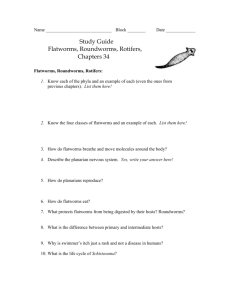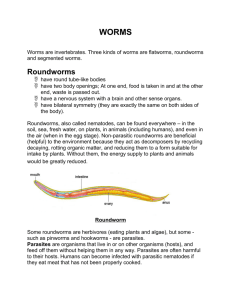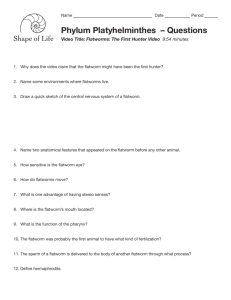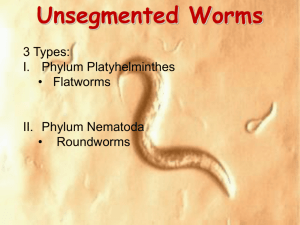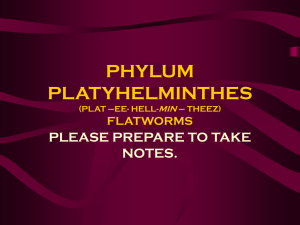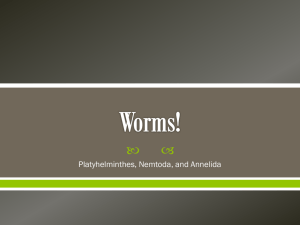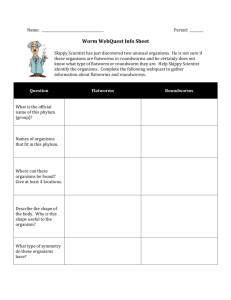The First Hunters: Flatworms!
advertisement
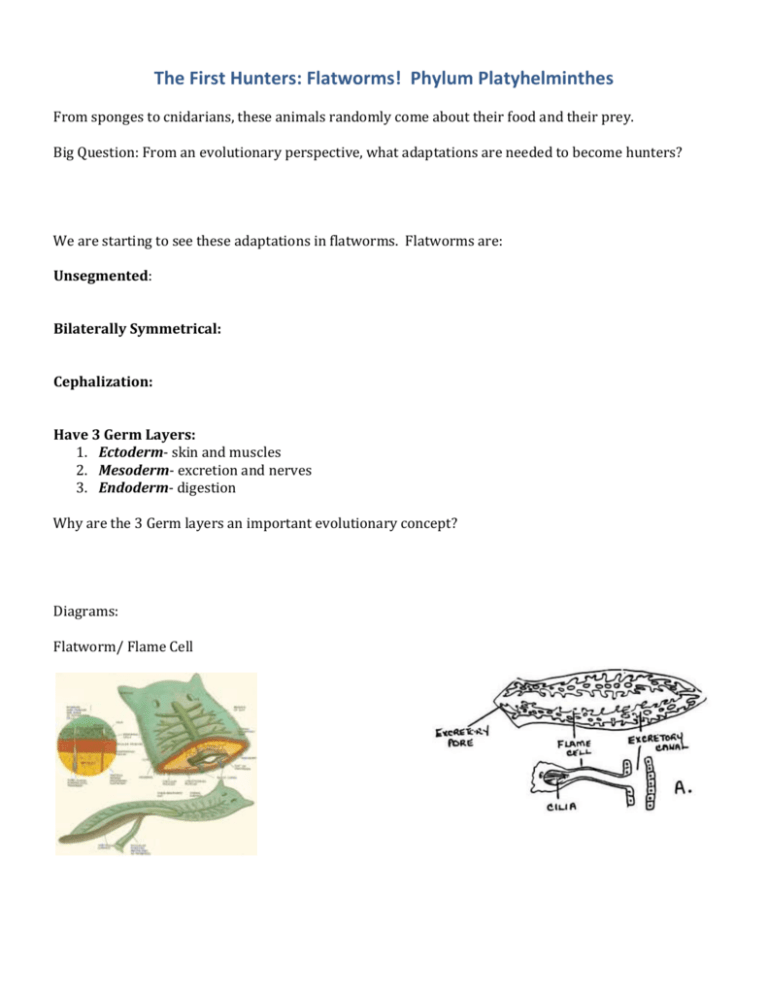
The First Hunters: Flatworms! Phylum Platyhelminthes From sponges to cnidarians, these animals randomly come about their food and their prey. Big Question: From an evolutionary perspective, what adaptations are needed to become hunters? We are starting to see these adaptations in flatworms. Flatworms are: Unsegmented: Bilaterally Symmetrical: Cephalization: Have 3 Germ Layers: 1. Ectoderm- skin and muscles 2. Mesoderm- excretion and nerves 3. Endoderm- digestion Why are the 3 Germ layers an important evolutionary concept? Diagrams: Flatworm/ Flame Cell So, in short, the Phylum Playthelminthes is the first group of animals that have a semblage of internal organs. How do flatworms acquire energy? 1. Free-living flatworms: 2. Parasitic flatworms: How would a branched gastrovascular cavity be beneficial to a small animal like a flatworm? How do flatworms reproduce? Most free living flatworms are hermaphroditic. Worms pair up and exchange sperm (re: Penis Fencing). Flatworms also reproduce ASEXUALLY by fission. This is similar to bacterial fission as worms splits in two and each half grows into new individuals. Others, like a tape worm, simply breaks into pieces and each piece grows into a new individual. How do flatworms expel wastes?- flatworms have specialized cells called FLAME CELLS. Flame Cells: cells that have a specialized function that remove metabolic wastes like ammonia and urea. These cells form a network of tubes that empty wastes through the ectoderm of the flatworm. How do flatworms respond to the environment? -Group of nerve cells concentrated in the anterior end of the body -Eyespots (group of light sensitive cells) located near head. -Chemo-sensitive cells located along the length of the body. Diagram: LIFE LOG: BIG UNDERSTANDING: Design an experiment that would investigate how sensitve the flatworm’s eyespots are. Your group must have a hypothesis, an independent variable, a dependent variable, a control and a plan to collect data. Flatworm Diversity: Over 20 000 species belong to Phylum Platyhelminthes. These species are divided within 3 classes: Class Turbellarians: Free living fatworms. Can live in Fresh or Marine water. Class Trematoda or Flukes: Parasitic flatworms hat infect the internal organs of their host. Class Cestoda or Tapeworms: Long flat parasitic worms that are adapted to life inside the intestines of their host. Phylum Nematoda: Roundworms; aka Nematodes Like bacteria, roundworms can be found in surprising number in a small area. A cubic meter of soil can be home to about a million roundworms! How can they reach such a great number? A roundworm can lay up to 200 000 eggs in a single day! Classification: Roundworms are: I. Unsegmented worms with tapered ends. II. Three Germ Layers: 1. Ectoderm 2. Mesoderm 3. Endoderm III. A Pseudocoelom: a space that develops between the mesoderm and the endoderm. Evolutionary speaking, this space is extremely important. Quick Question: What do you think a pseudocoelom can lead to? IV. A digestive tract with two openings. Notice every animal we’ve uncovered thus far (sponges, cnidarians and platyhelminthes) poop with the same opening they eat with. Luckily, this body plan has withstood the test of natural selection and our body plan has evolved from it. Diagram: How do nematodes acquire energy? -Free living nematodes are carnivores that grasp their prey with their mouths. Their prey can be small animals, algae, fungi or bacteria. -Some nematodes are parasitic and feed off host cells. How do nematodes excrete wastes and respire? - Roundworms use their body walls to get rid of wastes and to respire. They depend on the process of diffusion. Quick Question: Define Diffusion: How do nematodes respond to their environment? -Ganglion run up and down the roundworms body (similar to that of the flatworm). They also have chemoreceptors along the side of their body to detect prey. How do nematodes reproduce? -Nematodes reproduce sexually. Most species have separate males and females. Parasitic roundworms often have complex life cycles that require multiple hosts. Assignment: You are a Marketing employee for Health Canada. You are asked to Create a Wanted Poster for two Parasitic Flatworms and one Parasitic Roundworm to educate the public on how to avoid these parasites. A representative of Class Trematoda, Cestoda, and Phylum Nematoda must be presented. For the poster, the parasitic cycle should be diagramed (depicting their crime and their getaway against the host species) and explained as well as information of the disease or symptoms they cause. You should also provide ways for the public to protect themselves from the potentially dangerous parasites. Chapter 27 in your textbook can be your first source. Here’s how you’ll be assessed: Excellent 18-20 (A) Wanted Poster is clear, visually engaging and aesthetically pleasing. Evidence of time spent. Has 6+ pictures for each worm on the wanted poster. Pictures are large, clear and well labeled. Shows a deep understanding of the parasitic cycle. 6+ sources in bibliography. Written explanation is well written, concise with little or no grammatical or spelling errors. Written explanation is 300+ words. Has the ability to verbally explain the parasitic cycle and possible ways of defending or ridding of the parasite. Self Assessment: -_______/20: Explain: Mr. Jay’s Assessment: Comments: B I N B E T W E E N Acceptable 11-14 (C) Wanted poster is messy and at times unclear. Evidence of poster being put together last minute. 3- pictures for each flatworm on the wanted poster. Pictures are not very clear or not well labeled. Shows a satisfactory understanding of the parasitic cycle. 3- sources in bibliography. Written explanation is at times unclear and convoluted, with grammatical and spelling errors. Written explanation 180words. D Poor 0-7 (F) Poster is incomplete or incomprehensible. Has 1- pictures that are I unlabelled or unclear. N Shows little understanding of the parasites. B Shows little research into a E specific worm. T Written explanation is poorly W done with many grammatical E and spelling errors. E Written explanation is 100N words. Unable to explain their food chain.
